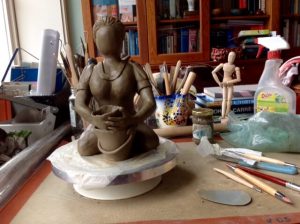
One cold and dreary autumn day in Holland, the faint call of the kiskadee in my head started to get louder and louder until it became too intense to ignore. It was time to take action.
There are few sounds from Guyana that I remember so well as the call of the kiskadee. Its shrill song resonated in the background as it flitted from branch to post, from wire to fence, calling out cheerfully and untiringly as its bright eyes gleaned a snippet of news from every yard. The story goes that the French interpreted the kiskadee’s cry as “Qu’est-ce qu’il dit?” – “What is he saying?” Do you want to know? Stay a while. My “ladies” and I will tell you.
Like the kiskadee, my ladies were always around. They too saw and heard most things. Collectively they exuded grace, kindness, warmth and good humour as they blended into the colourful blur of the background. They were no strangers to hard work and sacrifice and with a sigh of “Wha’ yuh gun do?”, they got on with life as best they could.
I wrote about food for several years. Not just recipes, but also from a social and cultural perspective. My books, essays and articles have been published around the world and I even managed to pick up a few awards along the way. I travelled extensively for research, gave lectures, made many new friends and taught people on several continents how to make things like paratha roti and dal puri as well as Sachertorte and speculaas.
After my fifth book, I decided that it was time to look for a new interest and turned to ceramics. I started out with bowls, plates and cake stands until a chance visit to an African museum inspired me to start making figurines. I posted photos of my creations along with little narratives on my private Facebook page, to entertain my friends and family. I turned it into a game, encouraging them to make up suitable names for the ladies. Happy memories flooded back and my friends soon started plying me with suggestions for new ladies.

My ladies mainly depict themes from village life as it used to be in the late colonial and post-colonial period of our childhood – a vanished era waveringly kept alive in our memories. The ladies are all lovingly created from high-quality materials and each one takes weeks to finish. The clay is hand-shaped, pre-fired, glazed and re-fired at a very high temperature to make women with soul and attitude.
Like my food writing, my ladies also have a social and cultural context. I write the Kiskadee Days stories in standard English, but conversations demand Creolese, as this is how my characters would speak. The Creolese words and expressions convey a depth of emotion, humour and feeling that would be quite lost in standard English.
Quite early on, the ladies were joined by a group of mischievous schoolboys, known as “de bodderashun lil bais” (the troublesome little boys). There are no sculptures of these little rascals, but their pranks and adventures keep my readers well entertained, especially when they get embroiled in scrapes with the Kiskadee ladies.
Posts on Kiskadee Village Life and News may vary greatly in tone depending on my mood and the circumstances. My daily dilemma is that the ceramics artist, food historian, self-appointed cultural guardian and warrior, storyteller and food historian factions within me are always jostling for prominence. As the ideas trickle, bubble, gush and explode, I try to get them to lead a balanced co-existence. With varying results. See for yourself and feel free to drop me a line or to comment so that others can also benefit from your thoughts.
